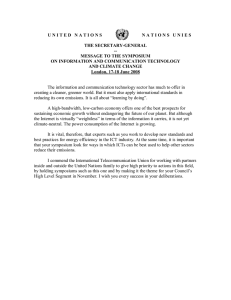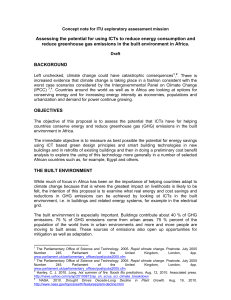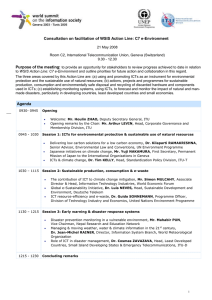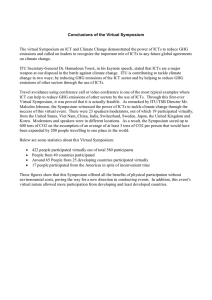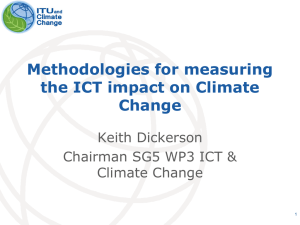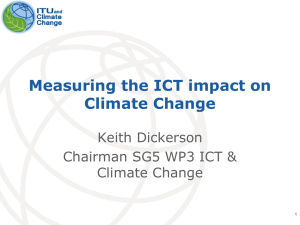- 1 - Focus Group on ICTs and Climate Change
advertisement
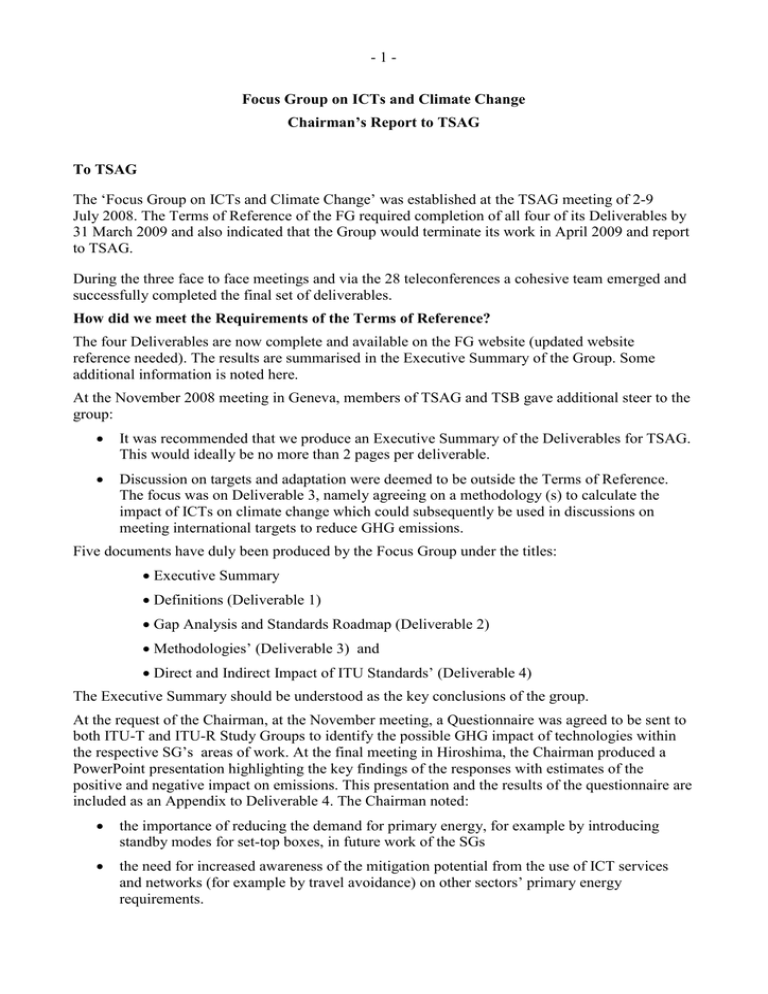
-1Focus Group on ICTs and Climate Change Chairman’s Report to TSAG To TSAG The ‘Focus Group on ICTs and Climate Change’ was established at the TSAG meeting of 2-9 July 2008. The Terms of Reference of the FG required completion of all four of its Deliverables by 31 March 2009 and also indicated that the Group would terminate its work in April 2009 and report to TSAG. During the three face to face meetings and via the 28 teleconferences a cohesive team emerged and successfully completed the final set of deliverables. How did we meet the Requirements of the Terms of Reference? The four Deliverables are now complete and available on the FG website (updated website reference needed). The results are summarised in the Executive Summary of the Group. Some additional information is noted here. At the November 2008 meeting in Geneva, members of TSAG and TSB gave additional steer to the group: It was recommended that we produce an Executive Summary of the Deliverables for TSAG. This would ideally be no more than 2 pages per deliverable. Discussion on targets and adaptation were deemed to be outside the Terms of Reference. The focus was on Deliverable 3, namely agreeing on a methodology (s) to calculate the impact of ICTs on climate change which could subsequently be used in discussions on meeting international targets to reduce GHG emissions. Five documents have duly been produced by the Focus Group under the titles: Executive Summary Definitions (Deliverable 1) Gap Analysis and Standards Roadmap (Deliverable 2) Methodologies’ (Deliverable 3) and Direct and Indirect Impact of ITU Standards’ (Deliverable 4) The Executive Summary should be understood as the key conclusions of the group. At the request of the Chairman, at the November meeting, a Questionnaire was agreed to be sent to both ITU-T and ITU-R Study Groups to identify the possible GHG impact of technologies within the respective SG’s areas of work. At the final meeting in Hiroshima, the Chairman produced a PowerPoint presentation highlighting the key findings of the responses with estimates of the positive and negative impact on emissions. This presentation and the results of the questionnaire are included as an Appendix to Deliverable 4. The Chairman noted: the importance of reducing the demand for primary energy, for example by introducing standby modes for set-top boxes, in future work of the SGs the need for increased awareness of the mitigation potential from the use of ICT services and networks (for example by travel avoidance) on other sectors’ primary energy requirements. -2Discussion of follow-on issues A PowerPoint presentation was prepared for the third and final meeting (March 24-27th) entitled ‘Issues for Future Work’. This was prepared by the Chairman and WG Chairmen using material from the 4 Deliverables and was presented and discussed at this meeting. It identifies issues which should be considered for further study by TSAG and for possible future Recommendations. This presentation is included as an Appendix to this report. Additional discussion of follow-on issues At the request of the FG Chairman and supported by the Management Committee, a final session was arranged at the Hiroshima meeting entitled “Additional discussion of follow-on issues”. The objective of this session was to ensure that any additional issues, not included in the ToR or Deliverables, could be identified. These are highlighted in the Hiroshima meeting report as follows. “This session was chaired by Arthur Levin, TSB Counsellor. It was intended to allow participants to provide some guidance to TSAG on other possible areas for future work on climate change not addressed in the Deliverables. A number of key issues were raised. Some noted that it is hard to set global targets for the reduction of GHG emissions, as different energy sources may be used, some of which can be renewable. Others commented that the methodology for measuring the impact of ICTs on climate change can be used to set targets for emission reductions (and to define targets) and noted the urgency of this work. Mr Quang Cuong, the representative from Vietnam, noted that adaptation is a key issue to be studied, as the impact of climate change is already being felt in his country in coastal areas and some villages will be lost. There needs to be more emphasis on ways in which ICTs can help developing countries to mitigate and adapt to climate change. As ICT is a fairly small share of GHG emissions, some felt that more effort should be placed on identifying key actions for the use of ICTs to reduce emissions in other sectors as well as any necessary standards. More studies on the use of ICTs to reduce emission in other sectors would be helpful, as well as work to indicate priority areas and sectors for attention. It was indicated that there is need for further study on recycling of ICT devices, which is mentioned in the deliverables, as part of a broader approach to ICTs and the environment further. There was discussion of the 2kW Society, an initiative mentioned in D3, and some expressions of support for the concept. Others cautioned that the 2kW initiative needs to take account of the ability of ICT to mitigate emissions in other sectors”. In addition the Chairman would like to note here that in an offline conversation during the final meeting, Malcolm Johnson said that the ‘effects of human factors’ and ‘sustainability requirements for batteries’ need to be included in any follow on work. Concluding Comments from the Chairman The problems addressed by the group were what is the impact of ICTs on Climate and what can be done about it. The consensus view of the group is that manmade emissions from greenhouse gases, in particular carbon dioxide, are changing the climate. Gases such as carbon dioxide and water vapour tend to -3raise the temperature whilst sulphur dioxide reduces it. Industrial processes need to be controlled and/or changed to prevent harmful pollution of the environment. ICTs have a direct impact when fossil fuels are used in the manufacture of ICT devices and an indirect impact if fossil fuels are used to energise the devices during the use phase. At the device and system level, by careful design it is possible to reduce the energy requirement and at the service level it is possible to emphasise the beneficial effect of substitution services such as travel avoidance. Both aspects need to be emphasised in future work. From the outset it was clear that different stakeholders took differing views on what needs to be done to minimise the overall impact of ICTs on the climate. These included operators, vendors, users and policymakers. So far, the ICT industry has been driven by the need for profit, for example by maximising growth and upgrade. These two factors act as multipliers which tend to drive GHG emissions up. Work on ‘methodologies’ provides a way to steer the work on future technologies in the right direction to minimise their overall impact on climate. Unlimited exponential growth should raise alarm bells to anyone with a mathematical or scientific background. The concern is how soon the technologies will become unsustainable through lack of resources and/or pollution. Growth in demand for ICTs will continue as more and more subscribers take up the technology until saturation is reached. For example around 60% world population has a mobile phone (4B) or access to a television (2B households). It is unreasonable to deny the remainder access to these devices in an effort to cap emissions. Attention must therefore be turned towards energy efficiency and the use of non-fossil fuel sources of energy. Upgrades, whereby new technologies are introduced with additional functionality, exert an extra multiplying effect on emissions and premature obsolescence. Such upgrades at the technology and service level are driven by Moore’s law and competition between vendors. The most popular formulation of Moore’s Law is the doubling of the number of transistors on integrated circuits every 2 years. Some references give the doubling period as low as 20 Months. Internet traffic, servers and networks tend to follow this trend. Office or domestic devices tend to be ‘obsolete’ in about three years. When to replace one device with a more efficient one is therefore an important issue for the ICT industry. This needs better understanding so that lifecycle emissions can be factored in to purchasing schemes. To gain control of ICT related emissions the following factors need to be considered. Switch to non-fossil fuel energy sources Reduced in-use energy demand through improved design and integration Introduce standby modes to exploit periods of quiet or low traffic Successive generations of access equipment need to operate with lower (not higher) energy requirements Longer life spans between replacement or upgrade need careful consideration Recycling should be maximised to reduce 'embodied emissions'. Acknowledgements The Chairman would like to thank the Vice-Chairmen: Yoh Somemura, Franz Zichy, Sungchul Kang and Nabil Kisrawi for their leadership, the Management Committee, the Director of TSB Malcolm Johnson, the Secretariat led by Art Levin (Counsellor) and the hosts of the Hiroshima -4meeting. In addition he would like to thank all contributors and participants. The Chairman welcomed important contributions from academia made possible by the open nature of Group. Appendix C:\documents and settings\802038539\My Documents\0809\focus group\Report to TSAG\26-March-1600-FG on ICT and CC issues for future work_r9.ppt
